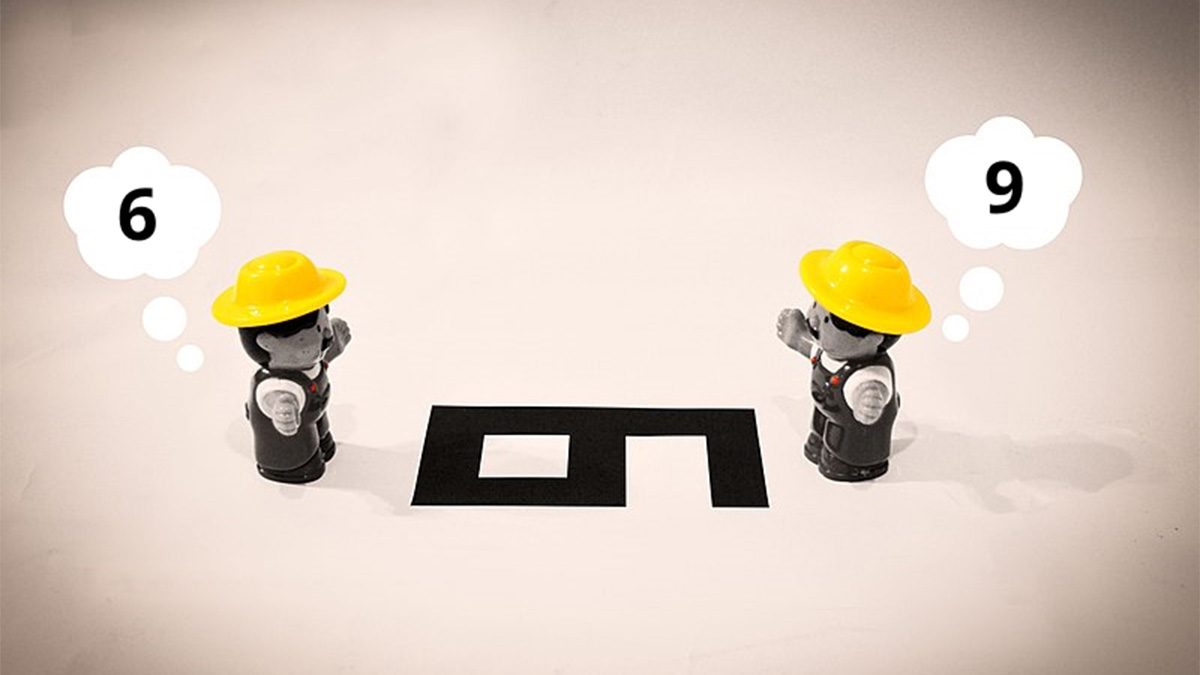Why Does How We Talk About This Matter?
Talking about design matters because when we do so, we talk about humanity—and humanity matters. It matters how we talk about design because words are the singular most powerful force available to humans.

Given the time most people spend surfing the web, I think most of us have come across some variation of the above image at one point or another. Often, it’s used to illustrate the importance of considering one’s perspective on something. Others have modified it in a number of ways to illustrate other points, such as the intentionality of whoever placed the number on the ground in the first place or how drawing a line on either side of the number would erase the ambiguity that brought about the debate in the first place. However, I would like to point to the insistence of these two individuals in classifying the number as either a 6 or a 9 and how that relates to talking about design.
If you have ever found yourself in a similar situation as the two individuals in the above image, you might have unknowingly been involved in a moment of design when you talked about what you saw and why you think it’s one thing or another. In other words, you were designating its place when talking about it.
Talking about design matters because when we do so, we talk about humanity—and humanity matters. It matters how we talk about design because words are the singular most powerful force available to humans. The reason why this is important is because the way in which we talk about stuff can potentially lead to important differences in establishing community, understanding, and mutually valuing each other.
How we talk about design matters because when we do so, we talk about humanity. Just like many of our fellow members of the animal kingdom, humans are adept at specific things. For one, humans are really good at creating lists. By this I don’t mean that we’re good at simply writing lists out (although writing is an awesome human feat in itself), rather, humans are really good at determining what goes where and why, as well as what makes one thing similar to another and dissimilar from the rest. That is, we are really good at designating things.
If it seems that “designating” and “designing” are similar, it’s because they are. Looking at the etymology of “design” helps us find what ties these words together.
Design: late 14c., “to make, shape,” ultimately from Latin designare “mark out, point out; devise; choose, designate, appoint,” from de “out” (see de-) + signare “to mark,” from signum “identifying mark, sign” (see sign (n.)).
As it seems, the origin of the word “design” comes from making or distinguishing something by a sign, thus giving it significance and designating its relation to other things—in other words, that thing that humans are really good at.
Human language, with its arbitrary sounds tied to certain meanings, is perhaps the most effective tool we have available to our species in designating and identifying things in the world. To be clear, however, I am not saying that designs are arbitrary like language is. Designed objects have properties (often physical) that directly tie them to their purpose and use, unlike language. Still, our language potentially represents the singular most powerful force available to humans when identifying things.
For this reason, it matters how the term “discourse” is employed when talking about design because how we talk about stuff can potentially lead to important differences in establishing community, understanding, and mutual valuing. Discourse, for me, is more than just a way of talking and in the case we present in this blog, it is a mode of organizing knowledge, ideas, or experiences that are rooted in “perceivable”—though not necessarily “concrete”—instantiations. Thus, the collection of people involved with this blog has identified five discourses (artifacts, processes, Experiences, systems, Culture) as a way to help us organize instantiations of design across contexts. You can read about these in more detail in our previous entry, but I include an overview below.

The use of “discourses” comes from our attempt at identifying and probing the realms of design that are applicable across any of its contexts. We employ these different yet related realms of discourses to designate reasonably understandable ways of talking about and understanding design. In other words, we attempt to hash out what goes where and why, as well as what makes one thing similar to another and dissimilar from the rest. This hashing out may involve categorizing things under one discourse or another or it may involve relatively placing something between or across discourses. That is, we are designating things in our world under discourses, trying to establish a communal way of understanding and mutually valuing design in all its richness.

Leave a Reply